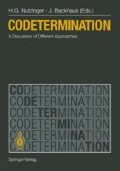Abstract
Attempts to compare the so-called “codetermined” firm with the “conventional” capitalist firm tend to run into difficulty quickly because there is, normally, no general agreement on the precise characteristics of the respective organizations being compared. Given the possible variations in the institutional arrangements of codetermination, many different types of codetermined firms are conceivable.1 Similarly, there are many variant forms of conventional (or non-participatory) firms. And, depending on structure, each separate firm, codetermined or conventional, can be expected to exhibit its own distinctive pattern of behavior. In principle, the new property-rights approach to comparative economics provides a general framework for analyzing the various organizational cases. By examining systematically the effects of different institutional configurations on transaction costs and economic incentives, predictions about the behavior of firms can be made. In this way,then, it is possible to relate variant models of codetermination to each other and to models of the conventional capitalist firm. But the possibility of conducting methodical analysis does not banish all problems. If, as we would anticipate, the behavior of a codetermined firm is quite sensitive to the specific institutional structure established to implement codetermination,2 the task still remains to define the particular type of codetermined firm we wish to consider. Moreover, if questions of relative efficiency are to be broached,it is also necessary to decide on the type of non-participatory firm that will be used as the basis for behavioral comparisons.
Access this chapter
Tax calculation will be finalised at checkout
Purchases are for personal use only
Preview
Unable to display preview. Download preview PDF.
References
Alchian, A.A. (1983), “Specificity, Specialization, and Coalition”, Working Paper, Department of Economics, University of California-Los Angeles, 1–36.
Alchian, A.A. (1984), “Specificity, Specialization, and Coalition”, Zeitschrift für die gesamte Staatswissenschaft, 140, 34–49.
Alchian, A.A. and Demsetz, H. (1972), “Production, Information Costs, and Economic Organization”, American Economic Review, 62, 77795.
Cable, J. and FitzRoy, F. (1980), “Productivity, Efficiency, Incentives, and Employee Participation:Some Preliminary Results for West Germany”, Kyklos, 33, 100–121.
Furubotn, E. G. (1985), “Codetermination, Productivity Gains, and the Economics of the Firm”, Oxford Economic Papers, 37, 22–39.
Furubotn, E.G. and Wiggins, S.N. (1984), “Plant Closings, Worker Reallocation Costs and Efficiency Gains to Labor Representation on Boards of Director”, Zeitschrift für die gesamte Staatswissenschaft, 140, 176–92.
Jensen, M.C. and Meckling, W. H. (1979), “Rights and Production Functions:An Application to Labor-Managed Firms and Codetermination”, Journal of Business, 52, 469–506.
Lutz, M. and Lux, K. (1979), The Challenge of Humanistic Economics, Menlo Park, California.
McCain, R.A. (1980), “A Theory of Co-Determination”, Zeitschrift für Nationalökonomie, 40, 65–90.
Mueller, D.C. (1976), “Information, Mobility and Profit”, Kyklos, 29, 419–48.
Oi, W.Y. (1962), “Labor as a Quasi-Fixed Factor”, Journal of Political Economy, 70, 538–55.
Steinherr, A. (1977), “On the Efficiency of Profit Sharing and Labor Participation in Management”, Bell Journal of Economics, 8, 545–55.
Svejnar, J. (1982a), “Codetermination and Productivity: Empirical Evidence from the Federal Republic of Germany”; in Jones, D. and Svejnar, J. eds.,(1982), Participatory and Self-Managed Firms, Lexington, Massachusetts.
Svejnar, J. (1982b), “On the Theory of a Participatory Firm”, Journal of Economic Theory, 27, 313–30.
Williamson, O.E. (1984), “The Economics of Governance:Framework and Implications”, Zeitschrift für die gesamte Staatswissenschaft, 140, 195–223.
Rights and permissions
Copyright information
© 1989 Springer-Verlag Berlin · Heidelberg
About this chapter
Cite this chapter
Furubotn, E.G. (1989). A General Model of Codetermination. In: Codetermination. Springer, Berlin, Heidelberg. https://doi.org/10.1007/978-3-642-61326-5_4
Download citation
DOI: https://doi.org/10.1007/978-3-642-61326-5_4
Publisher Name: Springer, Berlin, Heidelberg
Print ISBN: 978-3-642-64793-2
Online ISBN: 978-3-642-61326-5
eBook Packages: Springer Book Archive

